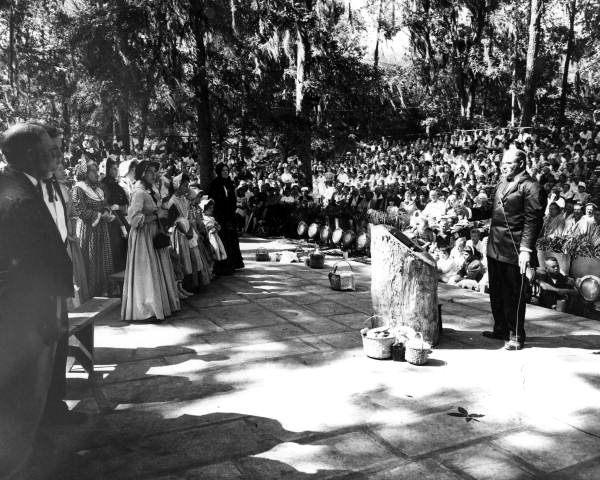Description of previous item
Description of next item
Gospel to Go: Circuit Riders on the Florida Frontier
Published August 8, 2014 by Florida Memory
It’s a cool Sunday morning in the sandy scrub of North Florida, with dew still on the ground and the sun just getting up over the trees. It’s 1847. Church is about to start, but it’s nothing like what most of us would think of when we think of church today. There is no church building; there’s only an arbor to shield the worshipers from the sun, a few crude benches, and a space at the front for the preacher. Moreover, the preacher arrives on his horse just before the service is to begin, because he does not live in the same community as his congregants. In fact, this is only one of half a dozen settlements he will visit in the course of a month.
This was the experience of worshipers who were ministered to by circuit riders, preachers who traveled from place to place offering religious services to settlers in far-flung corners of the Florida frontier. Sometimes called “saddlebag preachers,” these ministers typically traveled on horseback or sometimes in a wagon if the roads permitted. The communities they served comprised a “circuit,” sometimes with a permanent church headquarters in one of the larger towns. In the territorial and early statehood periods, with transportation difficult and communities spread far apart, circuit ministries were an efficient way of reaching the population. Circuit riding is particularly associated with the Methodist faith, although other denominations have used similar methods to reach their followers at various times.

Rev. Dwight F. Cameron, Jr. with his horse and buggy. Cameron was a circuit riding minister in Volusia County in the early twentieth century (1916).
The services at each station on the circuit might take place in a private home, a public building like the local courthouse, or under a “brush arbor,” a humble and temporary shelter that could be erected and expanded quickly. Later, as many communities expanded and their families became more prosperous, permanent church buildings began replacing the temporary brush arbors of earlier years. Better roads also made it easier for families living far away from established churches to come into town to worship. Over time, the circuit rider began to disappear as ministers were appointed for individual churches.

The United Methodist Church of Middleburg in Clay County, with congregants outside. The church was originally built in 1845. The photo dates to the 1880s.
The concept of open-air “camp meetings” and other religious services is still an attractive one for many, however, and modern versions still appear today. As a nod to the significance of this old Floridian tradition, several reenactments of a typical brush arbor church service have been performed at the annual Florida Folk Festival over the years.

Reenactment of a brush arbor church service at the Florida Folk Festival in White Springs (circa 1960s).
What’s the oldest church in your county? Did you know that Florida Memory has digitized the records of a WPA survey of more than 5,500 of the state’s churches? Visit the WPA Church Records collection, and search the Florida Photographic Collection to see if we have pictures of any of the churches in your community!
Cite This Article
Chicago Manual of Style
(17th Edition)Florida Memory. "Gospel to Go: Circuit Riders on the Florida Frontier." Floridiana, 2014. https://www.floridamemory.com/items/show/295206.
MLA
(9th Edition)Florida Memory. "Gospel to Go: Circuit Riders on the Florida Frontier." Floridiana, 2014, https://www.floridamemory.com/items/show/295206. Accessed December 31, 2025.
APA
(7th Edition)Florida Memory. (2014, August 8). Gospel to Go: Circuit Riders on the Florida Frontier. Floridiana. Retrieved from https://www.floridamemory.com/items/show/295206

 Listen: The Folk Program
Listen: The Folk Program